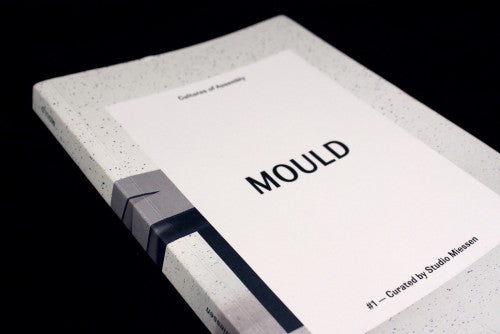
Out now: Mould #1

Mould’s concept is fascinating. Instead of organising their magazine thematically, they’re planning different guest editors for each issue, a ‘curator’ who will bring their own personal outlook to the magazine and who will ‘mould’ the pages. So as the magazine grows into subsequent issues, it will morph and change its tone every time. Issue one, launched at the recent Istanbul Design Biennale, has been curated by Markus Miessen of Studio Miessen, and he’s decided to title his version of the project the ambiguous sounding ‘Cultures of Assembly’. Essentially, he seems interested in notions of ‘space’, both online space and public space, and how we experience these spaces in the modern world.

One piece by Xerxes Cook applies a Jorge Luis Borges quote to the idea of Wikipedia, so that the online encyclopaedia seems to become the labyrinthine library from Borges’s famous short story ‘The Library of Babel’. For this piece, online space and fictional space eerily merge, and Wikipedia becomes a treasure trove containing strange stories waiting to be found (above).

A series of drawings called ‘Table Talk’ by Marcus Knupp contemplate how certain tables proclaim power while others attempt to democratise through their circular design.

A manifesto from artist Patricia Reed draws from the theories of Marx, Lefebvre and Zizek. It has been sparsely laid out with footnotes contained in the middle margin, a subtle and effective design motif peppered through the publication.

One of the most effective aspects of the magazine is that as well as stimulating the mind, curator Miessen has made sure that our eyes are stimulated as well. A visual manifesto for public space makes for a gorgeous visual essay at the centre of the magazine, and the spectrum of colours at the back, which detail facts about the specific tint of the page (above, below), is aesthetically appealing while adding pace to the run of pages.

Issue one of Mould brings together an interesting collection of writers, images, manifestos, design features and ideas. At times articles feel a bit opaque, but the application of critical theory to the modern world in the context of a magazine is potentially very exciting. It’s a trend that is slowly escalating, prevalent in new magazines that are cropping up like Pollen from Berlin. Mould calls for more critical thinking, which can only be a good thing, so let’s hope that their ideas spread.
Issue two of Mould is due this spring.
Review by Madeleine Morley.


